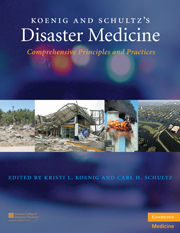Book contents
- Frontmatter
- Contents
- List of Contributors
- Contributor Biographies
- Foreword
- Preface
- Acknowledgments
- PART I CONCEPTUAL FRAMEWORK AND STRATEGIC OVERVIEW
- PART II OPERATIONAL ISSUES
- 9 Public Health and Emergency Management Systems
- 10 Legislative Authorities and Regulatory Issues
- 11 Syndromic Surveillance
- 12 Triage
- 13 Personal Protective Equipment
- 14 Decontamination
- 15 Quarantine
- 16 Mass Dispensing of Antibiotics and Vaccines
- 17 Management of Mass Gatherings
- 18 Transportation Disasters
- 19 Emergency Medical Services Scene Management
- 20 Healthcare Facility Disaster Management
- 21 Mass Fatality Management
- 22 Crisis and Emergency Risk Communication
- 23 Telemedicine and Telehealth Role in Public Health Emergencies
- 24 Complex Public Health Emergencies
- 25 Patient Identification and Tracking
- PART III CLINICAL MANAGEMENT
- Index
- Plate section
- References
10 - Legislative Authorities and Regulatory Issues
from PART II - OPERATIONAL ISSUES
Published online by Cambridge University Press: 05 August 2011
- Frontmatter
- Contents
- List of Contributors
- Contributor Biographies
- Foreword
- Preface
- Acknowledgments
- PART I CONCEPTUAL FRAMEWORK AND STRATEGIC OVERVIEW
- PART II OPERATIONAL ISSUES
- 9 Public Health and Emergency Management Systems
- 10 Legislative Authorities and Regulatory Issues
- 11 Syndromic Surveillance
- 12 Triage
- 13 Personal Protective Equipment
- 14 Decontamination
- 15 Quarantine
- 16 Mass Dispensing of Antibiotics and Vaccines
- 17 Management of Mass Gatherings
- 18 Transportation Disasters
- 19 Emergency Medical Services Scene Management
- 20 Healthcare Facility Disaster Management
- 21 Mass Fatality Management
- 22 Crisis and Emergency Risk Communication
- 23 Telemedicine and Telehealth Role in Public Health Emergencies
- 24 Complex Public Health Emergencies
- 25 Patient Identification and Tracking
- PART III CLINICAL MANAGEMENT
- Index
- Plate section
- References
Summary
OVERVIEW OF THE PROBLEM
Catastrophic disasters disrupt the health and medical system. Medical infrastructure (e.g., hospitals, clinics, doctors' offices, laboratories, pharmacies, and medical suppliers) may suffer physical damage, or lose electrical power or communications capabilities such as Internet and computer services. A disaster creates new requirements for medical care when large numbers of people suffer from serious injuries or infectious diseases or are exposed to chemical, radiological, or biological contamination. As demonstrated by the 2004 Indian Ocean tsunami and the 2005 Hurricane Katrina in the U.S., a disaster can generate evacuees in the hundreds of thousands that are separated from their regular medical care network (e.g., doctors, nurses, prescription medications, and medical records), yet continue to require baseline health and medical needs.
Catastrophic disasters also challenge the legal basis of the medical system. Compliance with some legal requirements becomes impossible and practitioners must be aware of current standards and legal mandates that exist in the disaster environment. For example, in the United States, federal rules require clinicians to perform a medical screening examination and stabilize any patient who arrives on hospital grounds requesting medical care. How does this regulation apply when there is a physical plant disruption such as a hospital flood or fire, or chemical or radiological contamination of the building? Another example is that virtually all sovereign governments ensure the competence of medical professionals by issuing licenses to those authorized to practice medicine within its borders – yet in a disaster, medical volunteers will cross state or national boundaries to treat disaster victims.
Keywords
- Type
- Chapter
- Information
- Koenig and Schultz's Disaster MedicineComprehensive Principles and Practices, pp. 151 - 164Publisher: Cambridge University PressPrint publication year: 2009



